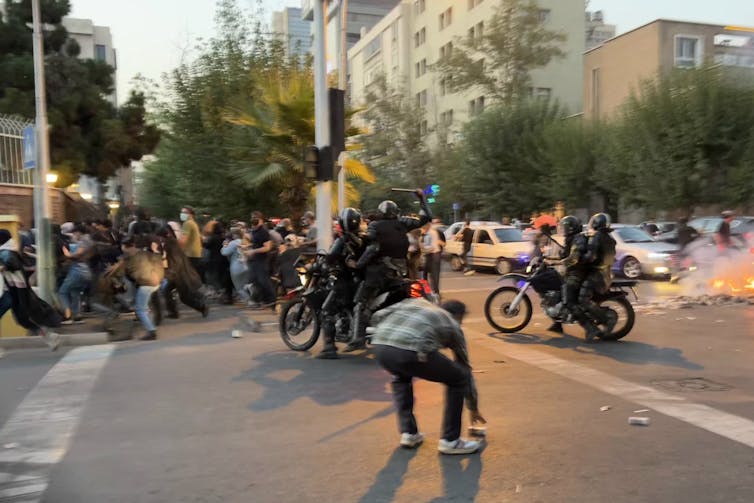The passing of Iranian President Ebrahim Raisi, who was killed in a helicopter accident in a mountainous border region on May 19, 2024, will be a severe blow to the country’s conservative leadership. Raisi was a consummate loyalist.
The corpses and detritus were discovered following an overnight search that was hindered by challenging terrain and inclement weather. Ayatollah Ali Khamenei, the Supreme Leader of Iran, declared that the nation would observe a five-day period of public mourning.
I am of the opinion that Tehran’s concerns may extend beyond the potential human tragedy of the accident, given my expertise in Iran’s domestic politics and foreign policy. The change it necessitates will have significant consequences for an Iranian state that is beset by domestic turmoil and regional and international instability.
What was the identity of Ebrahim Raisi?
Raisi has served as an assiduous apparatchik of the Islamic Republic and a prominent protégé of Khamenei, who, as supreme leader, retains the ultimate power in the Islamic Republic, since the Iranian Revolution of 1979.
Prior to his appointment as president in 2021, Raisi served in a variety of capacities within the judiciary, all of which were supervised by the top leader. He served as a prosecutor on the committee that sentenced thousands of political prisoners to execution at the conclusion of the Iran-Iraq War in 1988.
He was subsequently sanctioned by the United States and condemned by the United Nations and international human rights organizations as a result of the executions, which earned him the moniker “Butcher of Tehran.”
Raisi has been a member of the Assembly of Experts since 2006, a body that is responsible for the appointment and supervision of the supreme commander.
In spite of his perceived lack of charisma and eloquence, it was believed that Raisi, who is 63 years old, was being prepared to succeed the 85-year-old Khamenei as supreme leader.
A domestic document that undergoes verification
Both the cause and consequence of a legitimacy crisis and societal disorder for the regime were the domestic consequences of Raisi’s presidency.
After a historically low voter turnout of less than 50% and a high number of candidate disqualifications by the Guardian Council, which vets candidates, he controversially won the 2021 presidential election.
Raisi and his government reinstated religion restrictions and granted the morality police additional authority in order to satisfy their conservative supporters. The Women, Life, Freedom protests, which were initiated by the death of Mahsa Amini in police custody in 2022, were precipitated by this policy. The Islamic Republic’s demonstrations were the largest and longest in its nearly 50-year history. Additionally, they led to unprecedented state repression, resulting in the deaths of over 500 demonstrators and the injury of hundreds more, as well as the disappearance and detention of others. Raisi escalated crackdowns and restrictions during the protests to demonstrate his backing for the paramount leader and the conservative elites of the nation.

Iran’s economy continued to suffer under Raisi’s leadership as a result of a combination of government ineptitude and corruption, as well as U.S. sanctions that have been exacerbated in response to Tehran’s domestic repression and overseas provocations.
Differing opinions regarding the methodology
During Raisi’s tenure as president, Iran’s position in the region and globally underwent significant changes.
Khamenei is the ultimate authority and has the final say on all foreign policy. But Raisi governed a nation that persisted in its confrontation with its adversaries, particularly the United States and Israel.
Tehran has distanced itself from any notion of establishing a relationship with the West, regardless of whether they wish to or believe it is necessary.
The nuclear agreement has been hesitantly revived by Iran under Raisi’s leadership due to the escalating US sanctions. In its stead, Iran has increased the enrichment of uranium, prohibited foreign inspectors from entering, and established itself as a “nuclear threshold state.”
Raisi also maintained the “Look to the East” policy of his predecessor, Hassan Rouhani. This is the reason why he and his administration made an effort to fortify their relationship with China.
In March 2023, Beijing has provided an economic lifeline by importing Iranian crude and mediating a diplomatic agreement between Iran and Saudi Arabia.
During Raisi’s presidency, Iran remained a funding and ally in anti-US and anti-West conflicts, supplying armaments to a variety of regional proxies in the Middle East and delivering combat drones to Russia for use in Ukraine.
Iran, under the leadership of Khamenei and Raisi, has been able to maintain a delicate equilibrium between enabling its regional proxies to counter Israel and the United States while avoiding a direct confrontation with both countries, which are conventionally superior adversaries, since the war in Gaza began on Oct. 7, 2023.
In April, the Islamic Republic launched its first-ever direct attack on Israel with drones and missiles in retaliation for a strike on Iran’s consulate in Damascus. This incident temporarily disrupted the equilibrium.
Despite the fact that Raisi was not personally responsible for foreign policy, he was a significant advocate for the Iranian regime’s endeavors to diverge from the current international order and establish alliances with other nations that share its aversion to the West.
Raisi and his colleagues were returning from a ceremony in neighboring Azerbaijan to inaugurate a dam when their helicopter collapsed. The ceremony was likely designed to foster a relationship between Iran and Azerbaijan, as the two countries had previously maintained an ambiguous, if not adversarial, stance in the Nagorno-Karabakh conflict. This conflict culminated in a resounding Azerbaijani victory in late 2023.
What outcome could occur if the president undergoes a change?
Raisi was a potential successor, an insider in the government, and a longtime supporter of Supreme Leader Khamenei.
According to Iranian legislation, the first vice president assumes the role of president in the event of the president’s death. In this instance, it refers to Mohammad Mokhber, a politician who, like Raisi, has been a prominent member of the Iran team that has been negotiating weapons agreements with Moscow.
Additionally, Iran will be required to conduct presidential elections within a 50-day period. We are still uncertain about the individual whom the supreme supervisor would select as a potential successor and future president.
However, it is nearly certain that Tehran’s conservatives will continue to unite due to the significant amount of pressure they are facing from both within and outside the country.
This could result in increased state violence and manipulated elections in the United States. In my opinion, it may entail fortifying relationships with new acquaintances and preparing for conflict with long-standing adversaries, both domestically and internationally.







